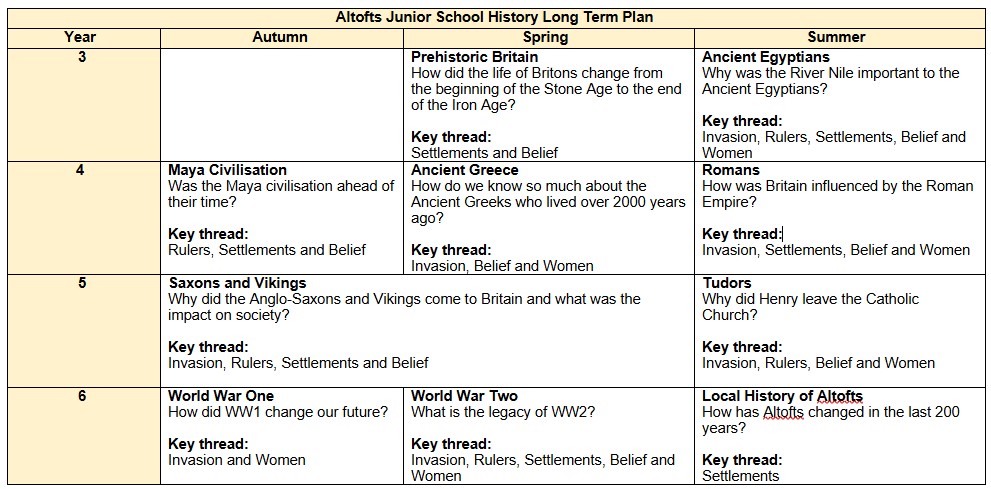History
Intent
At Altofts Junior School, our History curriculum develops an understanding of the past and how history will shape the future. High quality lessons inspire pupils’ curiosity to know more about the past. We want pupils to be passionate about History and our curriculum incorporates topics which foster awe and wonder. Teaching equips children to examine causes and consequences; identify change and continuity; investigate similarities and differences; investigate historical significance; use and evaluate sources and evidence; and construct their own historical interpretation. This allows them to build a historically rich vocabulary enabling children to talk accurately about the subject. This teaching is underpinned by core numeracy and literacy skills. Learning objectives draw knowledge and skills from the National Curriculum. Our History themes focus on the development of five common threads: invasion, settlements, beliefs, women and rulers. Throughout their study, children will gain a deeper understanding of the wider world, guiding them to become accepting and understanding of the differences in society, as well as developing their independence and resilience as a learner.
.
Implementation
History is taught in blocks throughout the year; hence, children can achieve depth in their learning. Key substantive knowledge, disciplinary knowledge and vocabulary are identified for each topic and this is built upon throughout the units, with explicit links made to the children’s prior learning. Children learn the history of Britain in a chronological order, as well as studying ancient civilisations and local history.
Children express their learning in a variety of ways including writing, discussion, drama and art. Children begin each topic with a ‘hook’ lesson to ignite their interest. Within the history units, we aim to develop children’s cultural capital with visitors in school alongside school trips and utilising a variety of historical resources; this extends children’s knowledge and skills further. Tasks are selected and designed to provide appropriate challenge to all learners.
Impact
As a result of our History curriculum, by the end of Year 6 pupils will have the following experiences and understanding:
- A secure knowledge of the chronology of British History
- Examine the causes and consequences of events in History
- Explain how the past can influence the present and future
- Analyse and evaluate sources to justify claims about the past, becoming increasingly critical and analytical with their thinking
- Develop appropriate use of a richer Historical vocabulary, enabling them to articulate their understanding of concepts taught
- Be immersed in topics through taking part in a variety of trips, visitors and experiences
- Have high aspirations for further study and work in their future

Knowledge Organisers
Year 3
Spring Term Prehistoric Britain
Year 4
Year 5
Autumn and Spring Term Anglo Saxons








